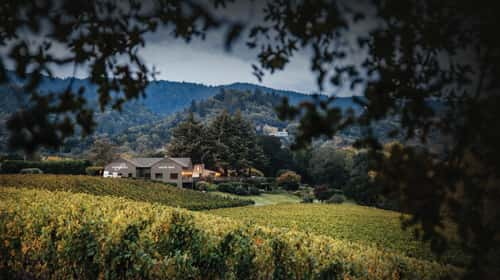The modest entrance of Passalacqua winery in the heart of Dry Creek Valley offers sweeping vineyard views and an inviting patio lounge seating area underneath the shade of coastal redwood trees, surrounded by maples ablaze with fall colors. A selection of wines is leisurely poured and the nuances of each wine is explained; where the grapes were grown, how each cluster was hand selected by the owner and winemaker, and lastly, how all the wines were produced on site and cannot be purchased elsewhere. What are missing are throngs of crowds elbowing each other at the tasting bar and huge tour buses parked outside. At Passalacqua, visitors are encouraged to savor and linger.
The experience of the boutique winery has become quintessentially Wine Country, as smaller wineries change their business model to differentiate themselves within a competitive market. Today, wine lovers are actively seeking unique wines that can’t be purchased by the masses at the neighborhood market.
In the wine industry, there isn’t one finite definition for what constitutes a “boutique” winery. Most winemakers agree that boutique means small, but even that distinction is up for debate—some categorize a boutique winery as producing 5,000 cases or less per year, some argue that less than 10,000 cases still applies. However, the majority concurs that boutique wines denote higher quality.
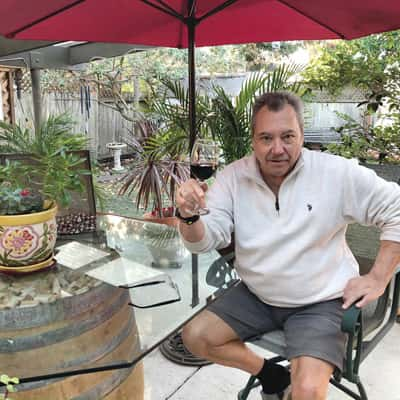 “A boutique winery is a family-owned winery and label, producing a small amount of wine from select blocks of fruit that are either owned by the family or outsourced,” says Alex Heck, board member of West Coast Wine Reserve. “Productions usually range from 200 to 2,000 cases to ensure the artisan craftsmanship and quality control are in the hands of the owners. Most growers with established names known for quality will vet the winemakers to make sure that when a signature vineyard or a designated block of fruit that defines a sense of place to knowledgeable wine buyers is on the label, it’s a vineyard designate known for quality and consistency within a given appellation.”
“A boutique winery is a family-owned winery and label, producing a small amount of wine from select blocks of fruit that are either owned by the family or outsourced,” says Alex Heck, board member of West Coast Wine Reserve. “Productions usually range from 200 to 2,000 cases to ensure the artisan craftsmanship and quality control are in the hands of the owners. Most growers with established names known for quality will vet the winemakers to make sure that when a signature vineyard or a designated block of fruit that defines a sense of place to knowledgeable wine buyers is on the label, it’s a vineyard designate known for quality and consistency within a given appellation.”
As far as Jason Passalacqua, owner of Passalacqua Winery in Healdsburg is concerned, “The term [‘boutique’] means overall small production, with small production lots and attention in the wine making process.” The family has been producing wine in the region for five generations and currently produces 4,500 to 5,000 cases per year of Cabernet Sauvignon, Zinfandel, and Chardonnay wines. “What also falls into that classification somewhere is how the wine is sold, with a large portion being direct to consumer through onsite tasting experiences, on the head of the barrel, in the cellar,” says Passalacqua. “The attention that one is given at the facility is a classic Wine Country experience. Boutique wineries are hard to define, but it’s some degree of all of those.”
It’s all in a name
Since the nebulous term “boutique” has in many ways become trite and overused, most wineries prefer a range of other terms such as “family-owned and operated,” “small production,” “artisanal,” or “sustainable,” to more adequately define who they are. “As time has gone on and with so many new wineries, the term [boutique] has gotten a little diluted,” says Tom Eddy, owner and winemaker of Calistoga-based Tom Eddy Winery, which started in 1991 and produces about 4,000 cases per year of mostly Cabernet Sauvignon from Napa Valley grapes. “A true definition of boutique should probably include a discussion about quality and notoriety.”
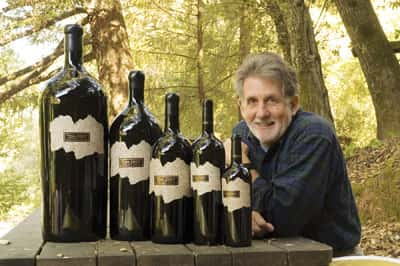 Another term still used in the media today is “cult” wine. Generally, the term is used for a wine in high demand, often generated by rave reviews and high ratings in respected wine publications, in conjunction with a low available quantity, resulting in extremely high-priced wines. “Typically, the way I look at the term ‘cult’ is a wine that is expensive, hard to find, and really hard to get,” says Eddy. “To me, that is how the term boutique morphed into this term ‘cult’. But now, it’s kind of a joke because there are so many small, new wineries that show up for the first time and maybe people know about them because they get a big score in a magazine such as Wine Spectator. And then suddenly, that’s the new ‘cult wine.’”
Another term still used in the media today is “cult” wine. Generally, the term is used for a wine in high demand, often generated by rave reviews and high ratings in respected wine publications, in conjunction with a low available quantity, resulting in extremely high-priced wines. “Typically, the way I look at the term ‘cult’ is a wine that is expensive, hard to find, and really hard to get,” says Eddy. “To me, that is how the term boutique morphed into this term ‘cult’. But now, it’s kind of a joke because there are so many small, new wineries that show up for the first time and maybe people know about them because they get a big score in a magazine such as Wine Spectator. And then suddenly, that’s the new ‘cult wine.’”
Small-production wineries
Regardless of the label, consumers are flocking to small production wineries for many reasons such as taste and flavor, supporting small businesses, and the need to understand where the wine comes from and how it’s produced. In addition, the number of boutique wineries today has sky rocketed. Numerous vineyard owners who simply sold their grapes to the large producers in the past are now delving into the winemaking business themselves, and many are successful.
“Initially, there was a handful of wineries, the pioneers of the valley,” says Hugo Maldonado, owner and winemaker of Maldonado Family Vineyards in Calistoga. The winery produces about 2,500 cases per year under the Maldonado label, and approximately 2,000 cases of wines under their Farmworker label, an ode to his family’s farming roots. “They grew and became large-scale wineries. Over the years, numerous growers found the wine bug instead of selling the grapes. They’re learning to process them and are making the wine themselves. They put a lot of effort and passion into growing the grapes and making the wine.”
The increasing number of boutique wineries entering the marketplace elevated the market awareness of these smaller players overall, and wine lovers today seek them out instead of going to, or reaching for, the internationally-known brand names. This has led to a growing appreciation for the quality that boutique wineries can produce, often difficult to duplicate on a large scale. “The main benefit of smaller producers is that we focus on making high-quality wines,” says Maldonado. “They’re small-batch wines that are made with a lot of attention to detail. We focus on growing high-quality grapes, and we do small batch wine making. You get more concentration of flavors and more attention to the wine making process, and the results are reflected in the bottle.”
Like cooking on a large scale, flavor profiles in large production winemaking can be more difficult to control. With some large producers processing wine in 10,000 to 50,000 gallon tanks, grapes often come from many different lots and the company is often more concerned about quantity and the cost of goods versus quality. There’s also a certain level of panache that comes with buying something that can’s be found elsewhere. With most boutique wineries selling their wine only direct to consumer through their tasting rooms and wine clubs, wine aficionados enjoy the exclusivity.
“As we move into this ‘Amazon world’ where you can buy anything, anytime, anywhere, it’s important for the consumer to find that wine and that experience that can’t be found or bought anywhere else,” says Passalacqua. “It gives them an experience that’s one-of-a-kind and unique. As well, the bottles they take home and share with friends set them apart from anyone else who can go to the store and buy that same bottle of wine. Everyone is looking for the product that isn’t mass-produced and made a commodity.”
Another benefit consumers experience with small-production wineries is the personal connection they feel to the family, the land, and their story. Much like the movement in agriculture to “eat local,” and understand where your food is sourced and what went into growing the produce, wine connoisseurs enjoy getting to know where the grapes were sourced, and what happened during that particular vintage year.
to the family, the land, and their story. Much like the movement in agriculture to “eat local,” and understand where your food is sourced and what went into growing the produce, wine connoisseurs enjoy getting to know where the grapes were sourced, and what happened during that particular vintage year.
They want to talk directly to the winemaker about the nuances that went into producing that particular vintage. It becomes more than just tasting a beverage, it’s a full experience that heightens the senses.
“When you find yourself dealing with a small, boutique, family winery, you’re buying a little piece of their love,” says John Viszlay, owner and winemaker of Viszlay Vineyards, located in Healdsburg. The winery produces 1,500 cases of 12 different varietals, all estate wines. “Heart and soul gets poured into everything you do. You can’t say that about a product coming out of the big guys – even though it may be a very nice wine, it just doesn’t have the love put in it that I put into mine.”
Small by choice
While the major players in the wine industry are continually striving for additional market share, these small-production wineries are purposely choosing to stay small to maintain the high level of care and dedication they put into making the best quality wine they can. “The plan is to never be over 10,000 cases, even under our most extreme growth,” says Maldonado. “We want to stay focused on producing high-quality wines. Once you start scaling up, you have larger inventory, you have to consider the cost of goods, and move the wine. If it’s sitting in a warehouse it’s generating expenses and we don’t want to be in a position where we have to just look at our bottom number. Our priority is always to make the highest possible wine quality.”
Many owners of small wineries also play the part of winemaker, which offers its own sense of enjoyment that they prefer not to relinquish were they to become larger. “I get a great deal of satisfaction in making the wine,” says Viszlay. “Tending the barrels, crushing the grapes, making those initial decisions about the type of yeast we’re going to use, the barrels we’re going to use, how long we’re going to age it. It’s all those types of decisions going in, and then tasting the results. That’s satisfying.”
Because of the changes in the wine industry and the plethora of new, boutique wineries in the marketplace today, small producers changed their business model from the old approach of using wholesale distributors to sell to restaurants and the retail market, to selling direct to the consumer.
“Over the years, we saw that our profitability was declining by selling to wholesale and then retail. Our goal and dream was always to have our own winery in Napa. But that became an economic necessity because we needed to switch gears to a more profitable business plan, which was selling direct,” says Eddy. Fifteen years ago, Eddy’s wholesale sales were 95 percent of revenue. Today, it’s 5 percent. For most small producers, it’s a survival mechanism to sell directly to consumers.
The challenges of being small
In a sea of hundreds of wineries in Napa and Sonoma Counties, it’s both a challenge for the wineries to differentiate themselves, and for consumers to know where to go, other than blindly stumbling into the nearest tasting room. An online presence and social media has helped. Apps such as Wine Routes help wine lovers plan their next day of tasting, based on personal preferences. Consumers are looking towards social media sites for recommendations of where to visit, and successful small wineries have taken note.
“It’s quite a game now, and it’s hard for small wineries to be competitive,” says Eddy. “How do you define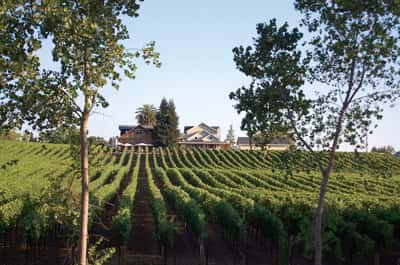 yourself, and stand apart from the rest of the crowd? Many small wineries today are doing that through social media, through direct consumer channels of sales. The old school way of 15 to 20 years ago of having one good article and selling your wine wholesale doesn’t work because it disappears into that void. Various, small, new wineries that do well have dynamic, robust direct-to-consumer marketing programs.”
yourself, and stand apart from the rest of the crowd? Many small wineries today are doing that through social media, through direct consumer channels of sales. The old school way of 15 to 20 years ago of having one good article and selling your wine wholesale doesn’t work because it disappears into that void. Various, small, new wineries that do well have dynamic, robust direct-to-consumer marketing programs.”
Some boutique wineries have also created relationships with tour guides and companies to drive in customer traffic. Some work with companies like West Coast Wine Reserve, an organization of wine advisors that search out unique, artisan wines for their clients. “Many people enjoy driving around and drinking what’s available,” says Heck. “A lot of people don’t know what they’re looking for until they find it. They can save themselves time and effort talking to somebody like me who knows their way around the wine world, and can steer them in that direction.”
Another challenge to a small producer are the myriad of regulatory and permit issues, that are largely the same no matter the size of the winery. Many have more than 20 permits from federal, state, county, and local jurisdictions, as well as OSHA, and of course various taxes. A small winery must absorb these fixed costs, whether they’re producing 4,000 cases or 4 million.
“Compliance is one of the biggest challenges I hear people struggle with day in and day out, just to get your winery legal,” says Heck. “ABC, ATF, everyone wants a part of you. There are all these little hoops you must jump through.” According to Heck, building a tasting room is a major hurdle. “I know wineries in their fourth year, trying to get in compliance with the cities changing the rules.”
While not every small winery is considered boutique, and since the term also denotes a certain level of quality, the best bet for consumers is to simply try them out. Tourists especially can be primarily attracted to the large, well-known names in the wine industry, but, as in many artisanal industries, bigger doesn’t always mean better. “People should try smaller, boutique wineries—all the producers that aren’t well known,” says Maldonado. “There are lots of great jewels out there. There are lots of family owned operations and great smaller wineries that don’t get the attention. I wish people wouldn’t just go with the staple of well-known wineries in the valley. They should be encouraged and brave enough to try our wines. I think they’d be pleasantly surprised.”
Trek Winery
County’s Urban Winery
Though it falls under the category of “boutique,” “family-owned,” and “artisanal,” Novato-based Trek Winery can add another classification, “urban.”
“We call ourselves an urban winery since we’re in a downtown, urban setting,” says Andy Podshadley, owner and winemaker of Trek Winery. “There were few urban-type wineries when we opened. What makes a boutique, family winery is the connection with our customers, especially in a town setting where there aren’t too many wineries in Marin. We’re the only one that’s a full-service winery and we have a good local and out-of-town client base that are supportive.”
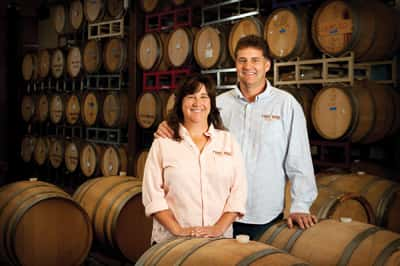 Starting in Sonoma in 2007, Trek Winery opened its first public tasting room in downtown Novato in 2012. Producing between 2,000 to 2,500 cases per year and using 14 different varietals (sourced from Sonoma, Napa, Amador and Solano counties), Trek prides itself on offering one of the few tasting rooms in Marin, but extends the idea of wine tasting into a lingering experience to enjoy and savor.
Starting in Sonoma in 2007, Trek Winery opened its first public tasting room in downtown Novato in 2012. Producing between 2,000 to 2,500 cases per year and using 14 different varietals (sourced from Sonoma, Napa, Amador and Solano counties), Trek prides itself on offering one of the few tasting rooms in Marin, but extends the idea of wine tasting into a lingering experience to enjoy and savor.
“It’s more than just a winery where people come and taste the wine and leave,” says Podshadley. “We’re more of a wine lounge, and neighborhood hangout place. I like to call it the ‘adult playground’ because it’s comfortable, and our music is good.” Trek offers seated tastings on leather couches and sofas, instead of bar stools or bars. As a result, the experience there is all about tasting small production wines from small family vineyards.
Trek Winery has become a venue for live entertainment to the public, as well as a venue for private gatherings, weddings, and other large events. Offering everything from Paint Nights, to comedy shows, and live music, Trek’s goal is to distinguish itself in this way to change its business model and sell primarily direct to consumer.
“In the old days, when I worked for the big wineries we had distributers all over the country and my job was to have them sell more of our wine,” says Podshadley. “But there are 50,000 wineries in the United States now. Every single state makes wine; so those distributors are overloaded, and the whole distributor-winery relationship has changed. It takes an individual winery a lot of effort to have your wines available in other states, and in restaurants and grocery stores. You can’t rely on a distributor to do that work because of the amount of wineries in this country.”
Podshadley estimates that approximately 90 percent of his sales are direct-to-consumer, with only 10 percent being sold through distributors to other states, and to local restaurants and stores. Due to the shift in sales distribution, Trek, along with most boutique wineries, have shifted their marketing focus to reach consumers directly.
“We’re off the beaten path, so that’s where the Internet comes in,” says Podshadley. “Through social media and sites such as Yelp, Google, and Trip Advisor, people can find us and smaller wineries.”


